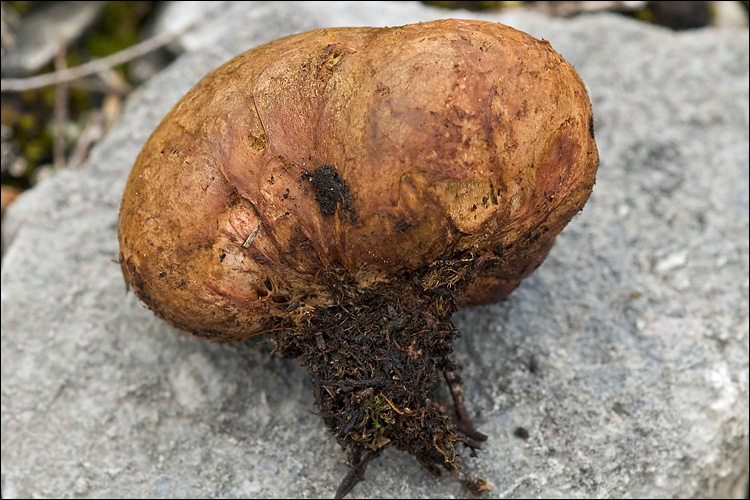|
Rhizopogon
''Rhizopogon'' is a genus of ectomycorrhizal basidiomycetes in the family Rhizopogonaceae. Species form hypogeous sporocarps commonly referred to as " false truffles". The general morphological characters of ''Rhizopogon'' sporocarps are a simplex or duplex peridium surrounding a loculate gleba that lacks a columnella. Basidiospores are produced upon basidia that are borne within the fungal hymenium that coats the interior surface of gleba locules. The peridium is often adorned with thick mycelial cords, also known as rhizomorphs, that attach the sporocarp to the surrounding substrate. The scientific name ''Rhizopogon'' is Greek for 'root' (Rhiz-) 'beard' (-pogon) and this name was given in reference to the rhizomorphs found on sporocarps of many species. ''Rhizopogon'' species are primarily found in ectomycorrhizal association with trees in the family Pinaceae and are especially common symbionts of pine, fir, and Douglas fir trees. Through their ectomycorrhizal relationshi ... [...More Info...] [...Related Items...] OR: [Wikipedia] [Google] [Baidu] |
Rhizopogonaceae
''Rhizopogonaceae'' are a family of fungi in the order Boletales. The family, first named and described by botanists Ernst Albert Gäumann and Carroll William Dodge in 1928, contains 2 genera and 151 species. The genus '' Fevansia'', formerly thought to belong in the Rhizopogonaceae, was found to belong in the Albatrellaceae in a molecular phylogenetics Molecular phylogenetics () is the branch of phylogeny that analyzes genetic, hereditary molecular differences, predominantly in DNA sequences, to gain information on an organism's evolutionary relationships. From these analyses, it is possible to ... study. References Rhizopogonaceae Taxa named by Carroll William Dodge {{Boletales-stub ... [...More Info...] [...Related Items...] OR: [Wikipedia] [Google] [Baidu] |
Rhizopogon Luteolus
''Rhizopogon luteolus'' is an ectomycorrhizal fungus used as a soil inoculant in agriculture and horticulture. It was deliberately introduced into ''Pinus radiata'' plantations in Western Australia after it was observed to improve tree growth. References External links * Rhizopogonaceae Fungi described in 1817 {{Boletales-stub ... [...More Info...] [...Related Items...] OR: [Wikipedia] [Google] [Baidu] |
Boletales
The Boletales are an order of Agaricomycetes containing over 1300 species with a diverse array of fruiting body types. The boletes are the best known members of this group, and until recently, the Boletales were thought to only contain boletes. The Boletales are now known to contain distinct groups of agarics, puffballs, and other fruiting-body types. Taxonomy The order Boletales originally was created to describe boletes, but based on micromorphological and molecular phylogenetic characteristics, a large number of nonbolete species have recently been reclassified to belong to this group, as well. The order also includes some gilled mushrooms, in the families Gomphidiaceae, Serpulaceae, Tapinellaceae, Hygrophoropsidaceae, and Paxillaceae, which often have the same flesh texture as the boletes, spore-bearing tissue which is also easily separable from the cap, and similar microscopic characteristics of spores and cystidia. Taxonomic studies using secondary metabolites an ... [...More Info...] [...Related Items...] OR: [Wikipedia] [Google] [Baidu] |
Ectomycorrhizae
An ectomycorrhiza (from Greek ἐκτός ', "outside", μύκης ', "fungus", and ῥίζα ', "root"; pl. ectomycorrhizas or ectomycorrhizae, abbreviated EcM) is a form of symbiotic relationship that occurs between a fungal symbiont, or mycobiont, and the roots of various plant species. The mycobiont is often from the phyla Basidiomycota and Ascomycota, and more rarely from the Zygomycota. Ectomycorrhizas form on the roots of around 2% of plant species, usually woody plants, including species from the birch, dipterocarp, myrtle, beech, willow, pine and rose families. Research on ectomycorrhizas is increasingly important in areas such as ecosystem management and restoration, forestry and agriculture. Unlike other mycorrhizal relationships, such as arbuscular mycorrhiza and ericoid mycorrhiza, ectomycorrhizal fungi do not penetrate their host's cell walls. Instead they form an entirely intercellular interface known as the Hartig net, consisting of highly branched hyphae formin ... [...More Info...] [...Related Items...] OR: [Wikipedia] [Google] [Baidu] |
Sporocarp (fungi)
The sporocarp (also known as fruiting body, fruit body or fruitbody) of fungi is a multicellular structure on which spore-producing structures, such as basidia or asci, are borne. The fruitbody is part of the sexual phase of a fungal life cycle, while the rest of the life cycle is characterized by vegetative mycelial growth and asexual spore production. The sporocarp of a basidiomycete is known as a ''basidiocarp'' or ''basidiome'', while the fruitbody of an ascomycete is known as an '' ascocarp''. Many shapes and morphologies are found in both basidiocarps and ascocarps; these features play an important role in the identification and taxonomy of fungi. Fruitbodies are termed ''epigeous'' if they grow on the ground, while those that grow underground are '' hypogeous''. Epigeous sporocarps that are visible to the naked eye, especially fruitbodies of a more or less agaricoid morphology, are often called mushrooms. Epigeous sporocarps have mycelia that extend undergroun ... [...More Info...] [...Related Items...] OR: [Wikipedia] [Google] [Baidu] |
False Truffle
A false truffle or a hymenogastrale is any species of fungus that has underground fruiting bodies that produce basidiocarps resembling the true truffles of genus ''Tuber Tubers are a type of enlarged structure used as storage organs for nutrients in some plants. They are used for the plant's perennation (survival of the winter or dry months), to provide energy and nutrients for regrowth during the next growin ...''. While rodents such as squirrels eat a wide variety of false truffle species, many are considered toxic (''Scleroderma'' species) or otherwise unpalatable and only a few are sought after as food. The rodents exist in an almost symbiotic relationship with the false truffle. The false truffle depends on the rodents to help spread its spores as it does not have the ability to eject the spores themselves. The rodents are attracted to a scent produced by the false truffle and ingest the spores. Spores survive the intestinal tract of the rodents and are excreted in the ... [...More Info...] [...Related Items...] OR: [Wikipedia] [Google] [Baidu] |
Coniferous Forests
Conifers are a group of cone-bearing seed plants, a subset of gymnosperms. Scientifically, they make up the division Pinophyta (), also known as Coniferophyta () or Coniferae. The division contains a single extant class, Pinopsida. All extant conifers are perennial woody plants with secondary growth. The great majority are trees, though a few are shrubs. Examples include cedars, Douglas-firs, cypresses, firs, junipers, kauri, larches, pines, hemlocks, redwoods, spruces, and yews.Campbell, Reece, "Phylum Coniferophyta". Biology. 7th. 2005. Print. P. 595 As of 1998, the division Pinophyta was estimated to contain eight families, 68 genera, and 629 living species. Although the total number of species is relatively small, conifers are ecologically important. They are the dominant plants over large areas of land, most notably the taiga of the Northern Hemisphere, but also in similar cool climates in mountains further south. Boreal conifers have many wintertime adaptations. ... [...More Info...] [...Related Items...] OR: [Wikipedia] [Google] [Baidu] |
Symbiont
Symbiosis (from Greek , , "living together", from , , "together", and , bíōsis, "living") is any type of a close and long-term biological interaction between two different biological organisms, be it mutualistic, commensalistic, or parasitic. The organisms, each termed a symbiont, must be of different species. In 1879, Heinrich Anton de Bary defined it as "the living together of unlike organisms". The term was subject to a century-long debate about whether it should specifically denote mutualism, as in lichens. Biologists have now abandoned that restriction. Symbiosis can be obligatory, which means that one or more of the symbionts depend on each other for survival, or facultative (optional), when they can generally live independently. Symbiosis is also classified by physical attachment. When symbionts form a single body it is called conjunctive symbiosis, while all other arrangements are called disjunctive symbiosis."symbiosis." Dorland's Illustrated Medical Dictionary ... [...More Info...] [...Related Items...] OR: [Wikipedia] [Google] [Baidu] |
Pine
A pine is any conifer tree or shrub in the genus ''Pinus'' () of the family (biology), family Pinaceae. ''Pinus'' is the sole genus in the subfamily Pinoideae. The World Flora Online created by the Royal Botanic Gardens, Kew and Missouri Botanical Garden accepts 187 species names of pines as current, together with more synonyms. The American Conifer Society (ACS) and the Royal Horticultural Society accept 121 species. Pines are commonly found in the Northern Hemisphere. ''Pine'' may also refer to the lumber derived from pine trees; it is one of the more extensively used types of lumber. The pine family is the largest conifer family and there are currently 818 named cultivars (or Trinomial nomenclature, trinomials) recognized by the ACS. Description Pine trees are evergreen, coniferous resinous trees (or, rarely, shrubs) growing tall, with the majority of species reaching tall. The smallest are Siberian dwarf pine and Potosi pinyon, and the tallest is an tall ponderosa pine lo ... [...More Info...] [...Related Items...] OR: [Wikipedia] [Google] [Baidu] |
Douglas Fir
The Douglas fir (''Pseudotsuga menziesii'') is an evergreen conifer species in the pine family, Pinaceae. It is native to western North America and is also known as Douglas-fir, Douglas spruce, Oregon pine, and Columbian pine. There are three varieties: coast Douglas-fir (''P. menziesii'' var. ''menziesii''), Rocky Mountain Douglas-fir (''P. menziesii'' var. ''glauca'') and Mexican Douglas-fir (''P. menziesii'' var. ''lindleyana''). Despite its common names, it is not a true fir (genus ''Abies''), spruce (genus ''Picea''), or pine (genus ''Pinus''). It is also not a hemlock; the genus name ''Pseudotsuga'' means "false hemlock". Description Douglas-firs are medium-size to extremely large evergreen trees, tall (although only ''Pseudotsuga menziesii var. menziesii'', common name coast Douglas-firs, reach heights near 100 m) and commonly reach in diameter, although trees with diameters of almost exist. The largest coast Douglas-firs regularly live over 500 years, with t ... [...More Info...] [...Related Items...] OR: [Wikipedia] [Google] [Baidu] |
Elias Magnus Fries
Elias Magnus Fries (15 August 1794 – 8 February 1878) was a Swedish mycologist and botanist. Career Fries was born at Femsjö ( Hylte Municipality), Småland, the son of the pastor there. He attended school in Växjö. He acquired an extensive knowledge of flowering plants from his father. In 1811 Fries entered Lund University where he obtained a doctorate in 1814. In the same year he was appointed an associate professorship in botany. He was elected a member of the Royal Swedish Academy of Sciences, and in 1824, became a full professor. In 1834 he became Borgström professor (Swed. ''Borgströmianska professuren'', a chair endowed by Erik Eriksson Borgström, 1708–1770) in applied economics at Uppsala University. The position was changed to "professor of botany and applied economics" in 1851. He was elected a Foreign Honorary Member of the American Academy of Arts and Sciences in 1849. That year he was also appointed director of the Uppsala University Botani ... [...More Info...] [...Related Items...] OR: [Wikipedia] [Google] [Baidu] |
Micromorphological
{{Wikidata redirect ... [...More Info...] [...Related Items...] OR: [Wikipedia] [Google] [Baidu] |


.jpg)




